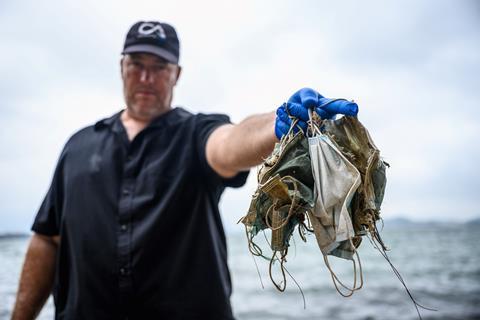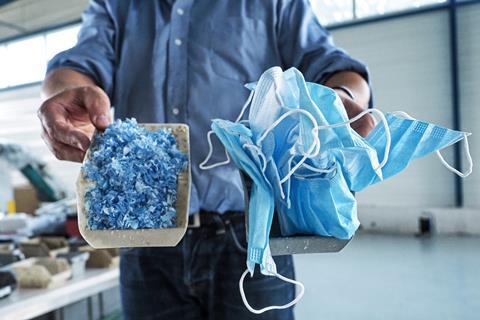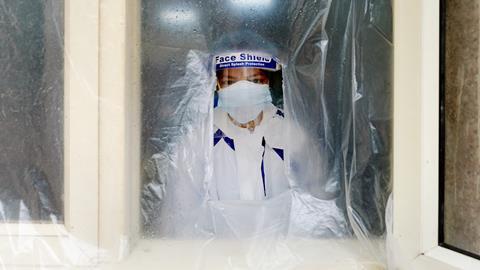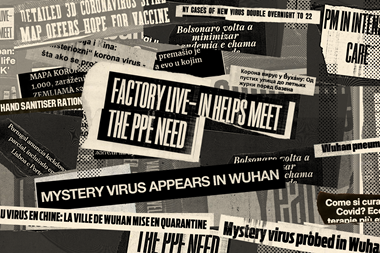Discarding our pandemic face masks could be an environmental disaster. Clare Sansom looks at the alternatives
Plastic is undoubtedly a problem. If current trends continue, its production will account for about 15% of all greenhouse gas emissions by 2050, and once produced it is notoriously difficult to dispose of. About eight million metric tonnes of the stuff enters our oceans each year and accumulates, proving deadly to many kinds of wildlife.
At least by the end of 2019, however, it seemed that campaigns to reduce and replace single-use bags and other plastic items were beginning to take off worldwide: inspired in the UK at least by the BBC’s documentary series Blue Planet II, narrated by David Attenborough. But all that changed in early 2020, and we are now in a very different world. Only a few months after the first cases of an unusual pneumonia appeared in China, certain plastic items – those used for personal protective equipment, or PPE – had become some of the most in-demand items around the world. Much of this is by nature single-use and it must all be disposed of, exacerbating the known problems with plastic waste. As Laurent Lombard of the French conservation group Operation Mer Propre told the UK’s Independent newspaper, ‘soon there will be more [discarded] masks than jellyfish in the waters of the Mediterranean’. So, as the pandemic will be here until we manage the huge feat of vaccinating billions of people, does the future have to be more plastic?
Soon there will be more masks than jellyfish in the Mediterranean
When thinking through the environmental burden of any product, it can be helpful to use a framework such as the ‘seven Rs of sustainability’: rethink, refuse, reduce, repurpose, reuse, recycle and rot. Generally, the optimum solutions for any problem are those nearest to the top of the list, but this cannot apply here. During a pandemic, refusing to use PPE or reducing its availability might be merely foolhardy (in a supermarket, for instance) but it would often be criminally dangerous. Therefore, we need to rethink PPE with sustainability in mind, and this mainly involves two things: moving away from single-use items wherever possible and changing the composition of the materials so they rot at the end of their useful life.
Reuse and rot
From an environmental point of view, an ideal material would have two attributes that are, in the real world, often incompatible: it would be both reusable and biodegradable. The single-use gloves that are almost ubiquitous in clinical care are often made from natural latex rubber, which is a polymer of isoprene (2-methyl-1,3-butadiene) extracted from rubber trees. This natural product biodegrades easily, and latex-based PPE causes little pollution. However, other types of PPE such as surgical gowns and masks are almost always made of oil-derived polymers such as non-woven or melt-blown polypropylene (PP). These are cheap, and they effectively protect the wearer from pathogenic microbes carried in droplets, such as Sars-CoV-2 – which is, after all, the point of using them – but they are not easily biodegradable. Non-woven polypropylene is commonly used to make the ‘bags for life’ promoted by supermarkets.

Replacing the oil-based polymers used to make surgical gowns and masks with biopolymers would reduce not only the ocean pollution produced by these all too durable single-use materials, but also their overall carbon footprint. David Fengwei Xie, a Marie Curie Fellow at the University of Warwick in the UK, is developing processes for transforming high-volume, low-value ‘biomass’ – either purpose-grown crops or agricultural waste – into higher-value biodegradable products, and these now include PPE. ‘Conventional oil-based plastics are light, strong and cheap, and it is relatively easy to design products that effectively repel bacteria and viruses using them,’ he explains. ‘It is much less easy to produce a sustainable biopolymer with the same properties, and the final products are still often more expensive and less reliable.’ Bagasse, the residue left when sugarcane stalks are crushed to extract juice, can be used to make materials with similar properties to those needed for disposable items, but they are not ideal. ‘Currently, they can do the job, but not as well [as traditional plastics],’ adds Xie. Plastic protective items with less stringent requirements, such as shields and visors, can be much more easily replaced with biodegradable alternatives.
Even if – or when – it becomes possible to switch to biodegradable polymers, however, there are other aspects of the PPE lifecycle to consider if it is to be made sustainable. The whole solid waste management strategy of cities and countries has been impacted by the unprecedented quantities of disposable materials required to protect against the virus. As one example, the total amount of medical waste generated in Wuhan, where the pandemic started, is expected to be at least 25% greater in 2020 than 2019. And Wuhan’s outbreak was relatively short-lived and well-contained. If the volume of (for example) discarded face masks is to be reduced, each face mask should be both biodegradable and reusable, and that can be addressed by using novel materials.
If you tax single-use materials enough, then anything that can be reused will be cheaper by comparison
Oladele Ogunseitan, a professor at the University of California Irvine in the US with a research background in microbiology and public health, turned his research group’s attention to novel materials for medical face masks when the pandemic hit the US in the spring. ‘Materials used for face masks have very specific requirements,’ he says. ‘They should be durable, cleanable and have pores that are large enough to be breathable but small enough to protect against all virus-laden droplets and aerosols.’ The solution that his and other groups are working on involves charged nanoparticles that repel viruses, are effectively self-disinfecting and can be embedded in plastic-based PPE or even in fabric masks. ‘Embedding these particles into masks and gloves should prolong their effective life,’ he adds.
The use of any genuinely novel material in a product as ubiquitous and useful as PPE during a pandemic will create problems as well as solving them, however, and the first of these is cost. Ogunseitan recognises this problem with innovative materials but believes that it could be short-lived, as the cost will fall with volume once production is ramped up. And regulation can help: ‘If you tax single-use materials enough, then anything that can be reused will be cheaper by comparison, even if the materials used are more expensive,’ he says. But as even the most advanced, ‘self-cleaning’ masks have a limited life, it will be important to make sure that all the materials used can be recycled.
On the other side of the Atlantic, a group of nanotechnologists and entrepreneurs based in Guildford, UK, found themselves in the right place at the right time when their startup grant from Innovate UK came through in April 2020. Their new company, Radical Fibres, uses a technique called electrospinning to produce flexible, fabric-compatible electrically sensitive nanofibres. Until the pandemic hit, they had been expecting to apply their technology to wearable electronics – running shirts with Fitbit-like technology built into the fabric, for example – but they rapidly realised that it could be more immediately useful if applied to face masks.
This technique involves drawing charged polymers from a solution into thin fibres. The fibres they are using in face masks are made from two polymers, including polyvinylidene fluoride (PVDF; [CH2CF2]n); they are piezoelectric, which means that they generate an electric charge when stressed mechanically. They can be spun into porous mats with a high charge and small pore size that traps virus particles very effectively while remaining breathable; this may be incorporated into either plastic or cloth masks as a separate layer. ‘This layer can give as much protection from viruses as the clinical standard N95 respirators that, by definition, filter out at least 95% of airborne particles,’ says Radical Fibres’ Rob Yates. ‘Cloth masks incorporating such piezoelectric filter inserts could provide the public with the same protection as a surgical mask, but they are light and easy to wear and, crucially, can last much longer than the standard cloth variety. Ideally, if made using an alternative bio-friendly material our masks could stay effective for about three months and then go in the compost bin.’
Cleaning up
Solving the PPE lifecycle problem does not only depend on novel materials, however. Effective decontamination can allow even standard PPE to be used many times, but the methods used must be chosen carefully and tested thoroughly so safety is not compromised. Decontamination protocols using vapourised peroxides are being scaled up for use worldwide, and several other decontaminants are under intense investigation.

You might not expect Nasa to have an interest in medical PPE, but scientists at its Glenn Research Center and physicians at University Hospitals Cleveland in Ohio, US, have been collaborating to develop and test decontamination protocols for reusing N95 filtering face respirators. They recently published a trial of a rapidly scalable room-decontamination technique for N95 respirators using peracetic acid (CH3CO3H) aerosols. Respirators that had been inoculated with highly heat-resistant spores of the harmless bacterium Geobacillus stearothermophilus or with the bacteriophage MS2, an RNA virus similar to Sars-CoV-2, were exposed to aerosolised peracetic acid. Each cycle lasts 76 minutes and can decontaminate about 2000 masks; this can be scaled up to decontaminate around 20,000 masks a day, enough to meet the PPE needs of a large tertiary care hospital. ‘We achieved a six-log reduction – that is, a reduction of 99.9999% – in both bacterial spore and viral contamination with a single decontamination cycle with peracetic acid. We also were able to ensure that the N95 masks could be decontaminated and reused using this method at least five times without any deterioration in the filtration or fit of the mask’, says Shine Raju, an intensive care specialist at UH Cleveland. ‘The results with the spores were particularly impressive as they are highly resistant to temperature and other commonly used disinfection methods. They are hardier than viruses such as coronavirus: if you can kill a spore, chances are you can kill any microbe.’
Sharon Miller and her team at Nasa’s Glenn Research Center are adapting a decontamination method first used for art restoration. This method originally developed out of observations that isolated atoms of oxygen encountered in outer planetary orbits break carbon–carbon and carbon–hydrogen bonds to make volatile oxides. Such reactivity enables atomic oxygen to break down organic compounds, including the fatty membranes of bacteria and viruses. ‘A similar method was investigated for decontaminating mail during the anthrax scare of 2001,’ remembers Miller.
Atomic oxygen is, however, difficult to work with as it is so reactive and short-lived that it must be made in situ in a near-vacuum environment. The Nasa team’s technique involves heating ozone in a chamber containing the PPE to be decontaminated to a temperature of around 55°C: ‘about as hot as an ordinary hair-dryer’. Even at this temperature, ozone decomposes to form one molecule each of atomic and molecular oxygen; each isolated oxygen atom lasts just long enough to break a carbon–hydrogen or carbon–carbon bond if it encounters one. Enough of these reactions will destroy the fatty membrane surrounding a virus. ‘We are testing this technique on the same N95 respirators, and we hope that it will be as successful,’ adds Miller. ‘And there is no reason why either technique shouldn’t decontaminate other types of PPE, such as surgical gowns, equally well.’
Cost considerations
The public health challenges of the pandemic are even harder to meet in middle- and low-income countries than they are in wealthier ones. Middle-income India has the second highest coronavirus caseload in the world, but its experience of previous epidemics has given scientists and policymakers a head start in developing some appropriate management strategies. Vikram Saini of the All India Institute of Medical Sciences in New Delhi has spent most of his research career working on tuberculosis, but when the pandemic hit India he was called in to help. PPE was in short supply and his group was able to devise a rapid and safe decontamination protocol that would enable it to be re-used if required. This method, which also uses vapourised hydrogen peroxide, can be set up in any healthcare facility and the process takes no more than about half an hour. ‘The only breakdown products of our process are water and oxygen, so it is completely safe and there are no environmental contaminants’, says Saini. ‘It is also cost-effective and easy to implement.’
The future does not need to be more plastic
The Covid-19 pandemic is certainly teaching us a great deal about the manufacture, recycling and disposal of plastics and novel materials. The important question, however, is how far will this new knowledge make our pandemic practices more sustainable? Xie is quite optimistic that it can, but he believes that this will require the kind of international cooperation and joined-up thinking that now seem to be in particularly short supply in many countries. ‘The pandemic has made us think about plastics more deeply,’ he says. ‘The future does not need to be more plastic … but we must remember that battling plastic waste in the long term is even more complex than battling the virus is today.’
Clare Sansom is a science writer based in Cambridge, UK













No comments yet